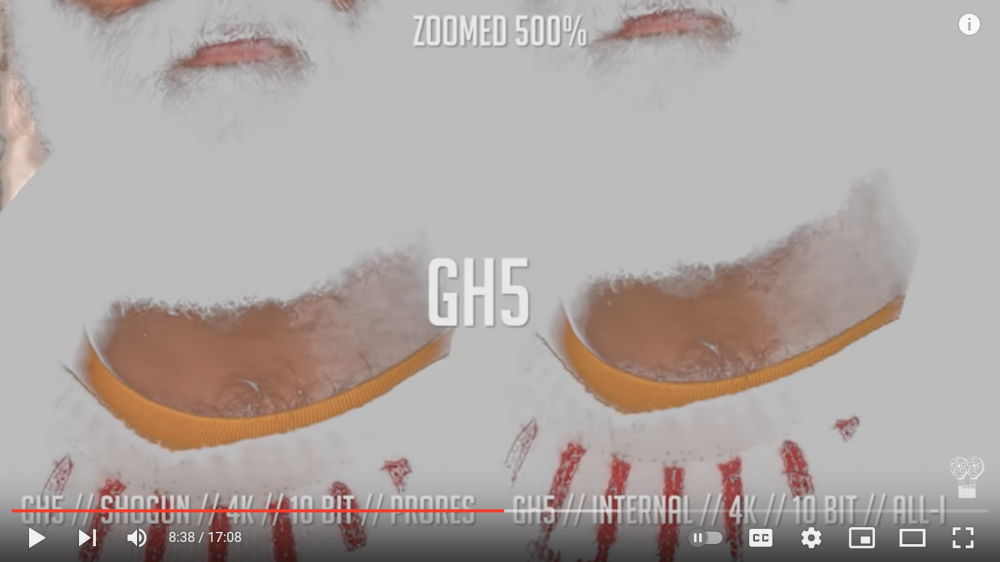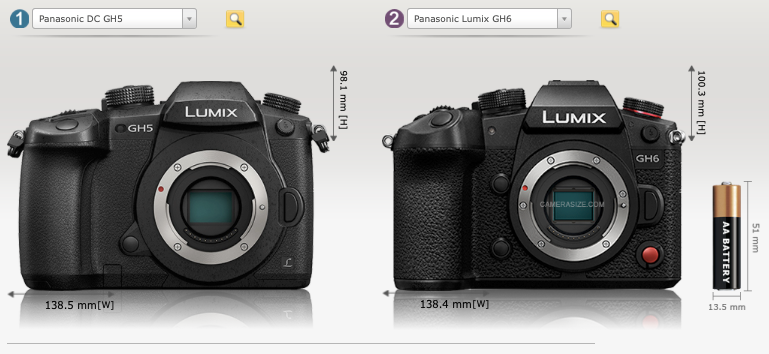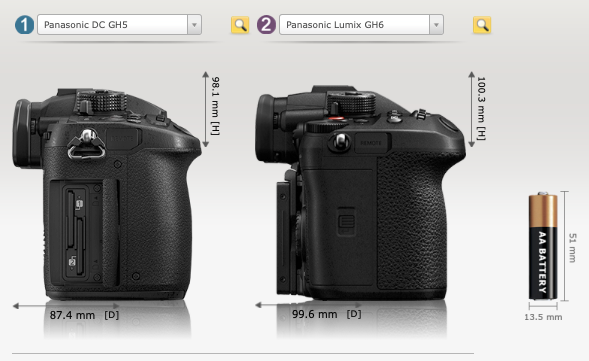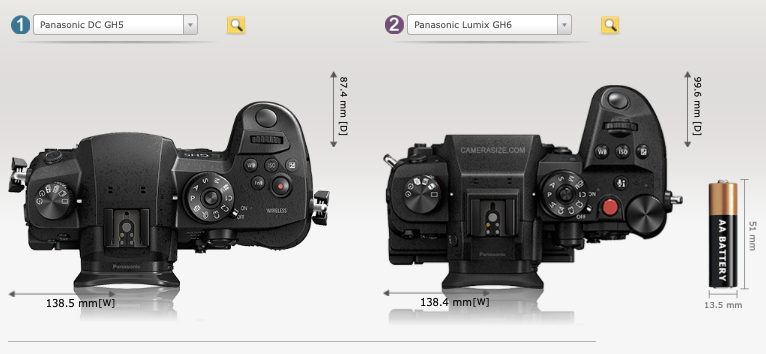-
Posts
7,504 -
Joined
-
Last visited
Content Type
Profiles
Forums
Articles
Everything posted by kye
-
Panasonic have announced that it'll get external RAW with Atomos recorders. My question is, have any of the cameras with internal RAW started off with external RAW only? I'm thinking that the external RAW may be an indicator that they've chosen that direction, rather than internal RAW. This makes sense, especially considering that Prores is internal, so even those who want to use a professional codec have an option for internal recording and the run-n-gun minimalist approach that this offers.
-
According to the CineD tests, here's the GH5 and BMPCC: and the GH6 has 12.8 / 11.5, so it's almost 2 stops, and slightly over the BMPCC sensor, which has a size disadvantage, but it's a reasonable question - technology marches on and 2012 was a looooooong time ago in silicon technology. It'll be interesting to see how it feels when I get one - the differences between the DR on the two cameras is very obvious when you take them out in the real world on a sunny day, that's for sure!
-
It depends on what you're trying to do really. Before the DSLR revolution shooting a video was likely an auto-SS kind of situation and shooting a film was more of a completely controlled full-manual situation. Really, the concept of shooting something that looks like a film but is shot like a video (ie, with no control over the situation) is something quite new and quite indulgent, in a sense. To want it all, so to speak. I will be the first to admit that it's what I do, I absolutely want to walk around in the world waving a camera around with one hand and somehow miraculously getting silver-screen quality images. Vloggers and low-budget film-makers and corporate and wedding and event videographers are often in this camp as well. But the industry hasn't really caught up. It will, and I'd imagine that in 5 years or so many video-first cameras will have auto-eND filters in them that can do it for you. I look forward to that day, but in the meantime I just use auto-SS for my videos (as they are actually videos) because for what I shoot, speed matters in getting the shot, where I currently sometimes catch the moment only by a couple of seconds and if I added having to adjust exposure to my camera operating responsibilities then I'd often miss shots entirely.
-
The HLG profile isn't exactly a standard (I've tested it) but it's relatively close to Rec2100 so you could try converting from that to V-Log and try the LUT on that. @hyalinejim might clarify the exact settings for that, but if you have a moment you could potentially try?
-
I suspect that they might be pushing the limits of the current technology so who knows what would be possible and what wouldn't be possible. I do know that CPU manufacturers have been hitting limitations on the technology and then having breakthroughs to surpass those limits every few years for decades and decades, and they're normally related to how small you can make things, so having a 6K sensor with all the processing and all the ADCs etc might well be nearing a limit, especially once you factor in the dual-gain functionality. Both the C70 DGO sensor and the Alexa ALEV sensors are lower resolution and physically larger, so they might be really pushing it - who knows. Panasonic were pretty good about squeezing lots of stuff out of the GH5 in firmware updates, so I'd imagine they'll do the same with the GH6, so watch this space 🙂 The slow-motion is one thing the GH6 has really upped, with the 4K120 and 1080p240 10-bit at 800Mbps, which is a huge upgrade from the 1080p 8-bit VFR bitrates on the GH5. I wear polarising sunglasses basically the whole time I'm outside (Australia has much more glare than most other places) and I frequently see strange things like patterns in different types of safety glass and strange reflections / textures from objects etc that are to do with the polarisation of the light. Even the blue of the sky doesn't look even because the polarisation of the very left of the sky is different from the middle and from the very right side, so lots of strange polarisation happens in real life. I don't shoot with NDs so I normally don't see these issues, but yeah, it's an interesting one. Might be worthwhile getting a set of fixed NDs to give you flexibility in case you hit something that just reacts strangely with the vNDs you have, and then you can just dial things in and fine-tune with aperture if required.
-
Yeah, send me a few frames - happy to have a play.
-
I was really happy when I realised that the GH5 2x in 1080p was downsampled - it is even downsampled in the 1080p60 too, so if you shoot 1080p ALL-I codec then you get full-readout and 2x digital zoom downsampled in every framerate, and you also get the 1:1 ETC which is a ~2.5x zoom. How odd that the larger cameras don't have as good video modes in this way. The GH5 was the flagship though so maybe the S1H has those modes? Fascinating about the 16-bit output. I guess it might depend on the sensor mode. IIRC other sensors sometimes have a higher bit-depth readout mode with limited fps, and then a reduced bit-depth mode where they get higher fps readouts, so maybe the 16-bit can only happen at 10fps or something. It would be great to see if that's possible at the 60fps speeds that the DR boost feature can do for video. That makes sense. Potentially then it's quite a different equation for your ND setup, but I keep thinking that all you need to do is work out what the maximum and minimum amount of ND you will need in daylight and just buy a fixed ND that compliments your vND to give you that range. Then after sunset you remove the fixed ND and your vND should cover the range of shooting under artificial lights. ISO 2000 should be a good base ISO for most low-light situations, so you should be using your vND even after dark anyway. The GH6 is 5760 x 4320 and the GH5 is 5184 x 3456 so if you multiply those out then you get a 38% increase in total number of pixels, or a 11% increase in width, so not entirely sure where they're getting that number either. Still, it's more pixels, and not stupidly more pixels, which is probably the right balance. Yeah, odd, but I agree that the GH6 is a winner. I see so many tiny little improvements they've made - I was contemplating writing a summary of what improvements I see that would be relevant to me in the real world and how I shoot. The ISO performance on the GH6 is pretty darn good!
-
Makes sense. That means that 3 extra stops of ND are required between modes, but would someone really be swapping between them? Most likely someone would already own a different camera and have the NDs setup for that, so it would be dependent on the ISO they currently shoot in, wouldn't it? You're the first other person I know that shoots 1080p and uses the 2x digital zoom to get a downsampled 1080p from the ~2.5K middle part of the sensor. The quality is so nice and the 2X is so handy that my lens collection has evolved to make full utilisation of those, by having a 17.5mm as my default lens which gives a 35mm FFE FOV and a 70mm FFE FOV from the same lens with just a button press.
-
True, but I'm not sure what you were referring to? I've heard that most professional productions shoot Prores rather than RAW, and that RAW is typically only used by the big budget productions and by amateurs. I'm keen to hear more about that. it makes sense to me, but my experience of the internet camera ecosystem (YT, social media, forums like this) and also of most solo-operators is that they're completely insulated from the industry proper, who interact in parallel discussions like liftgammagain.com, the CML mailing list, etc, and who have very different working methods and mindsets to the whole topic of making films.
-
Great stuff - thanks for posting! Very nice overall production and really nailed the whole 80s aesthetic. Some great lens flares in there too, and some vertical streaks (at 2:30 from the neon sign) - how did you get those? are they a normal property of the Kowa? and, of course, I have to ask.... did you get to ride in the Ferrari??? 🙂
-
Absolutely! I find that most camera discussions happen in a vacuum, where there is little consideration of anything else involved in the process, which is especially perplexing considering that the camera is one of the least important parts of making a good film. In terms of workflow, I shoot the GH5 using its 1080p ALL-I codec, in preference to the 4K IPB one, because of workflow considerations. I'll definitely be exploring the Prores options of the GH6, but will also be quite tempted by the Prores on the new iPhones, which are probably one of the cameras that would benefit most from having a larger bitrate and some gentle encouragement not to process the living hell out of the image before it's compressed and saved internally.
-
The older I get the more I realise that people seem to operate without much consideration (or often knowledge) of history and the broader context. Changing your mind on a subject you've already expressed a position on also requires admitting you were wrong, which seems to be an unacceptable cost in many cases too. The human condition is a strange thing!
-
This is where I get confused - there are actually 4 base-ISO settings aren't there? V-Log with DR boost and without, and non-V-Log profiles with DR boost and without. I thought that the ISO 250 was the Base ISO for non-Vlog profiles, and the 2000 was for V-Log and DR boost? The reason I raise that is that if you're talking about NDs, then people will be setup to expose with whatever profile they were using before, so V-Log GH5 -> V-Log GH6 DR boost. Very few people are going to have NDs for GH5 normal profiles and want to move to V-Log DR boost on the GH6 (and if they do then getting new NDs isn't unreasonable). Pity about the eND... it's basically the only thing that will get me to shoot manual mode rather than aperture priority, and I'd like to, but having to manually fuss with NDs is one step too far for me.
-
I did consider that but didn't think that you'd be doing anything as radical as a green screen or background replacement etc. What kinds of secondary adjustments would you really notice a poor quality codec? Genuinely curious. It all depends on what you're doing and the application of the format. Really this thread is relevant for people who aren't really sure of why Prores is a good feature, and often they're satisfied with h264 or h265 because they're "better", but if you're going to be doing work where you're really seeing the differences between these codecs then you're not the one who needs convincing! Sadly, lots of people start with the position that 'newer is better' and 'more is better' without actually applying those statements to the entire pipeline, to the implications on set or in post. I'd say that the quality of the encoder is probably more relevant in this case. As an example, the C100 provided an image that compared favourably to other cameras with double the bitrate, so obviously Canon had really made the encoder work hard and really get a good result. Cheap cameras can produce horrific results with heaps of bitrate. The difference that 8-generations of compression made was far far smaller than the difference between a C100 image and most other cameras, even those downsampling 1080p from a 4K sensor, so that's why I didn't consider it to be particularly relevant. I'm super happy the GH6 has prores and think it's one of the (many) great upgrades over the GH5, so I'm definitely with you on this one!
-
Absolutely. In the real world we're probably talking about the difference between 100Mbps h265 or 240Mbps h264 ALL-I (both from A73) vs 700Mbps All-I Prores HQ, or similar. Or, comparing Prores HQ with RAW but where RAW requires an external recorder and costs many hundreds of dollars and requires cables, extra batteries, more things to charge, etc etc.
-
DO NOT EVER THROW AWAY A WELL REGARDED LENS WITH GOOD GLASS IN IT!!! Seriously, I'm on the VLFV Facebook group and there are people constantly on the lookout for vintage lenses to re-house, and if it's a classic zoom then that may include those models too. Even if the front element is scrap there's probably another copy somewhere else where the rear element is scrap and together they'd made a great finished lens. These things aren't being made any more and are only going to get rarer. As the price of Leica R and CZ sets go through the roof people are talking about other lens lines more and more, eventually they'll get around to EF and zooms I'd imagine. Cool test - thanks for posting. If acting ability was critical for lens tests then I'd be sitting at my desk looking worried and compulsively drinking coffee too!! Especially considering that it looked like espresso shots with every sip being a bottoms-up situation!
-
The GH5 is relatively unique in that it offers a good selection of ALL-I codecs, which I use and are just wonderful in post. I guess other cameras would benefit from this though, as not many other models/manufacturers seem to have this included. Interestingly, I thought for the test I would encode and re-encode each codec over and over again until one of them started breaking down, but I setup ffmpeg to do that on a 1080p version (to save processing time) and after 8 generations on h264 IPB at the same bitrate as Prores HQ I had to pause because the file looked the same. At first I thought that ffmpeg was being too clever for me and just copying the stream instead of re-encoding it, but when I zoomed in crazily (something like 800%) there were subtle differences. So really, all else being equal and when given enough bitrate, they all do a great job, so it's really the other factors that I highlighted in my post that are the deciding factors. I suspect you are talking about this video? This is probably the part you're referring to? I found it hard to tell TBH, even with it moving, but that is a comparison between Prores on the Shogun, which is either HQ at 700Mbps or Prores 422 at 471Mbps vs the GH5 codec which is 400Mbps, so there's not much difference in the bitrate there. The 400Mbps is on the high side compared to most cameras bitrates, and with the GH6 in 5.7K they'd be looking at 1500Mbps or 1000Mbps, which are significantly more again, so the bitrates really are pretty serious. TBH, there's a point in diminishing returns with bitrate, not just because of accuracy vs bitrate, but also that if you multiply the resolution and bitrate by 9x (1920 x 3 is 5.7K) you're not increasing the size of the screen that the viewer will view the image on, so actually, once there is sufficient bitrate to render the screen to a certain optical quality it doesn't really require much more if you increase the resolution on the same display, or at least, it doesn't need to increase by a factor of 9. Of course, if you're doing green-screen or other hard-edged keying, cropping in post, stabilising significantly, compositing and other VFX operations then that's a different story, but those are specialist applications and not general ones.
-
I don't have any experience with those power zoom lenses, but one feature that I think would be of huge benefit from them is the ability to hold down the zoom rocker just a bit and do a smooth zoom during a shot. The more serious MFT lenses are nice, but I'm not sure that the manual zoom ring is damped and smooth enough to really pull off a flawless zoom during a shot, certainly my second-hand 12-35mm and kit 14-42mm zooms aren't. That was a thing that those ENG lenses were really good at weren't they? Definitely agree there. In terms of firmware updates, do we even know when the camera will be shipping? I haven't seen anything about it so am curious. No point having firmware updates if no-one has the camera!! I'll be curious to see what the math is like for shooting at, say, f0.95 in bright sun, at ISO2000 for high DR mode, and what that equates to in an exposure time. I did note that they improved the shortest shutter time of the camera, so maybe that is why. Not much good having a camera that can't expose properly in aperture priority mode while wide open at noon - that would be seriously embarrassing I'd imagine! In terms of ISO2000 compared to 800 (wasn't 800 the native ISO for Vlog on the GH5?) isn't it only slightly more than a stop more exposed? If so, you only need to add a single-stop of ND to your setup and it's the same. Or am I missing something?
-
I must admit, I'm not that surprised that a bunch of folks on a forum don't understand the market as much as they think they do! Still, it bodes well for both OM and also the MFT system in general, which by extension is good for all consumers as it encourages competition. As much as FF enthusiasts are quick to point out that FF is now a serious competitor to MFT in specs, I wonder if it wasn't for the MFT manufacturers pushing things forward if FF would be nearly as advanced now as it is.
-
I think it was the combination of the screen and the fan. I'm super happy with it as it's not too much larger and it's not larger from the front, which is what matters from the perspective of shooting in public and not gathering too much attention. By the time you put a lens on a camera, then depth of it is huge so a few extra mm isn't a big deal. My suggestion is to start with how and where you shoot and work backwards. For events you'll probably be valuing flexibility over other performance, so you're probably talking about zooms. Then the question comes of how much you care about having a long zoom range vs having a faster aperture. At one extreme you've got the 12-35mm F2.8 which is the fastest but shortest zoom, then things like the 12-60mm F2.8-4, then all the way to 12-100mm F4 and even the 12-200mm F3.5-6.3. I don't shoot events but my understanding is that mostly there is decent light, and many here have commented that the longer zooms work best because you're always just a zoom adjustment away from the shot. Especially with the improved low-light from the GH6.
-
The size comparison is available now on camerasize.com: https://camerasize.com/compare/#698,888 Panasonic DC GH5 is 0% (0.1 mm) wider and 2% (2.2 mm) shorter than Panasonic Lumix GH6. Panasonic DC GH5 is 12% (12.2 mm) thinner than Panasonic Lumix GH6. Panasonic DC GH5 [725 g] weights 12% (98 grams) less than Panasonic Lumix GH6 [823 g] (*inc. batteries and memory card). Panasonic DC GH5 dimensions: 138.5x98.1x87.4 mm (camera body only, excluding protrusion) Panasonic Lumix GH6 dimensions: 138.4x100.3x99.6 mm (camera body only, excluding protrusion)
-
In addition to the above, one thing I saw recently (can't remember where though!) was that someone was shooting film and wanted to have much lower saturation skies instead of bright-blue skies, so they overexposed the film and then developed it darker to normalise the exposure. This gives much less saturated skies as it pushed all the highlights up into the highlight rolloff where there's much less difference between the R G and B levels, and thus less saturation. The skies were a pale blue rather than saturated and it gave a kind of look to the skies vaguely reminiscent of the bleach-bypass look. That's also the kind of thing you can do with a Film Emulation LUT - raise the levels beforehand and then lower them afterwards and see the effects.
-
There are a few advantages to using in-camera EIS, so it's worth experimenting with (on non-critical footage) to get a feel for it, but mostly doing EIS in post is more flexible as it's not burnt in and you can try different things to see what works.
-
This forum is also social media.
-
A key point that I feel is worth mentioning here is that you can't expect a LUT to grade your film for you. What I mean by this is that you should be adjusting the image before putting it through the LUT (grading "under" the LUT) and potentially adjusting the overall levels after the LUT too, for more overall adjustments. Grading under the LUT is simply adjusting the images exposure, WB, contrast, and other attributes, which is the same as adjusting the lighting ratios on set, the exposure of the camera and WB of the scene while shooting on film. If you don't like the amount of contrast in a LUT, lower the contrast after you apply the LUT and adjust to taste prior to the LUT. If you want a stronger look then increase the contrast before the LUT and lower it afterwards and you'll get a more pronounced look, or do the opposite. These are creative tools, not one-click grading machines 🙂








